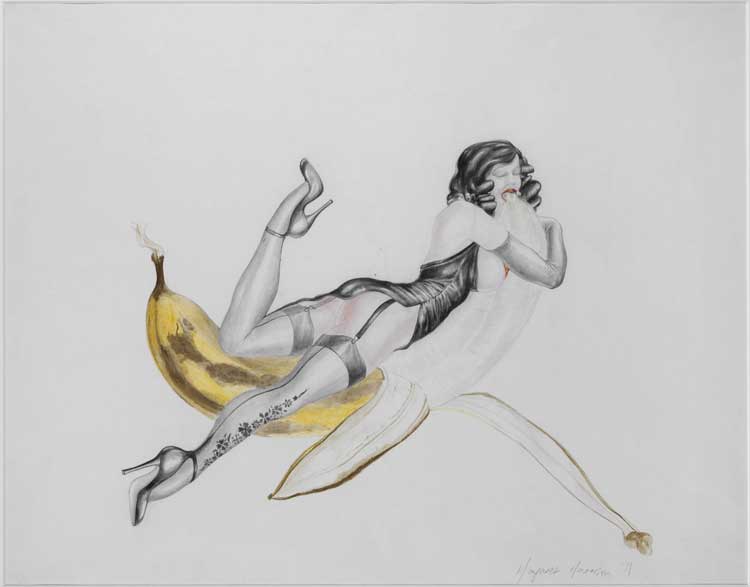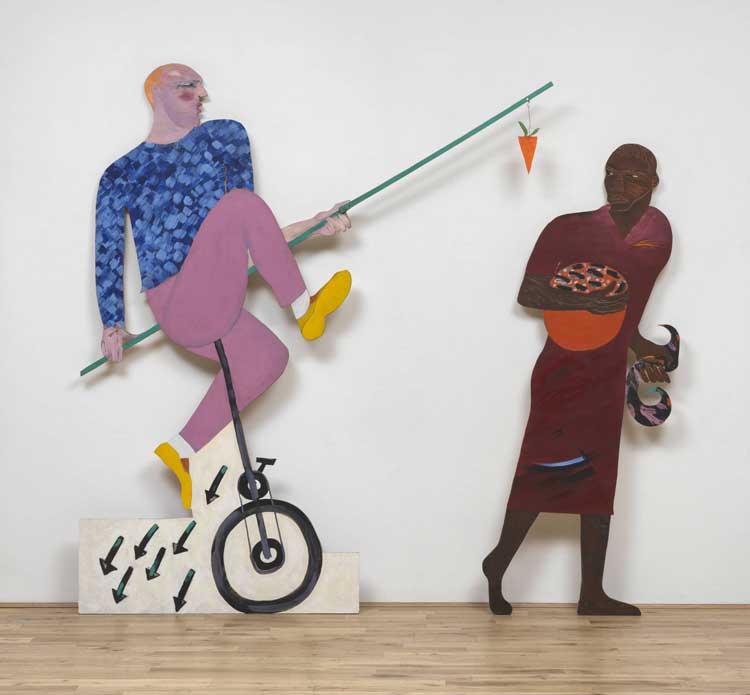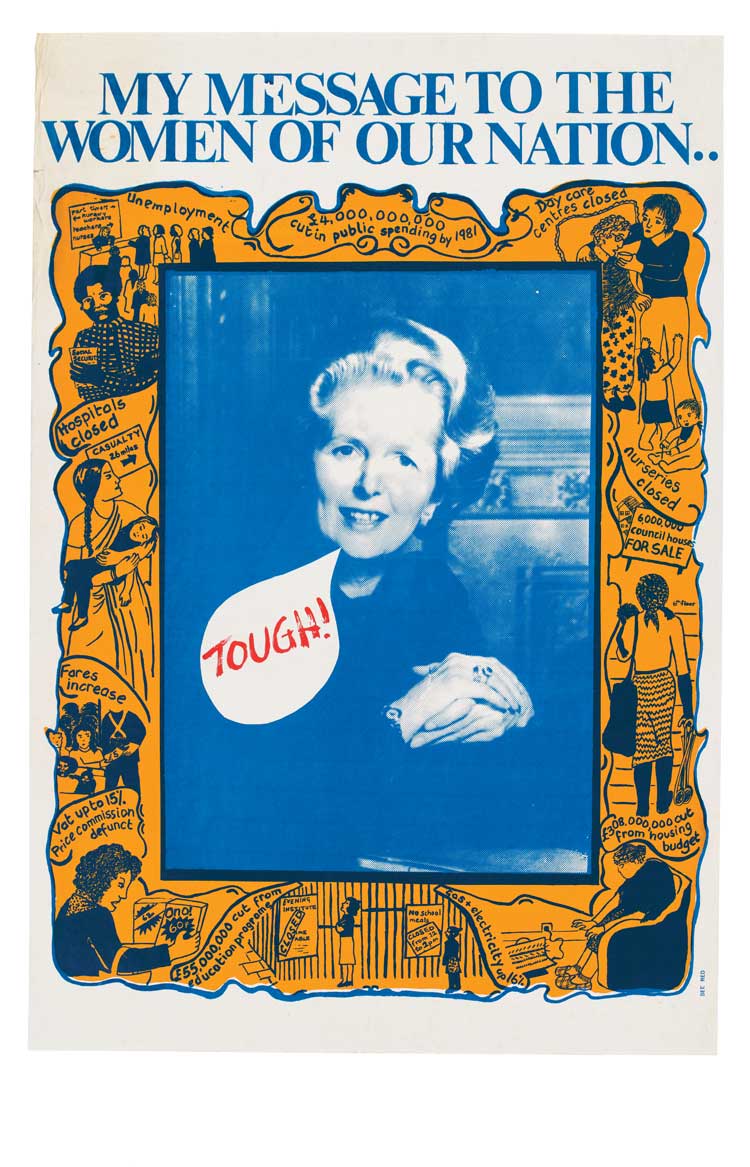-(1).jpg)
Maureen Scott, Mother and Child at Breaking Point, 1970, installation view, Women in Revolt!, Tate Britain, London, 2023 © Tate (Larina Fernandes).
Tate Britain, London
8 November 2023 – 7 April 2024
by BETH WILLIAMSON
My journey to Tate Britain to see the opening of Women in Revolt! was, rather appropriately, disrupted by a protest outside Westminster. The meandering detour I made to avoid the crowds and the police cordons turned out to be the perfect way to focus my mind in preparation for this exhibition. It allowed me to clear some head space for a show that is a tour-de-force – powerful, emotional, political and radical. There are already two major shows in London dealing with women’s protest in one form or another. Radical Landscapes, at the William Morris Gallery in Walthamstow, includes a strand on women, landscape and protest, starting with the works of Claude Cahun and Jo Spence, whose pioneering photography explores gender by placing the feminine body in nature. And it also includes the documentary shots of the Format Photographers Agency, which immortalised the Greenham Common Women’s Peace protests of the 1980s and 90s. Then there is the Barbican’s Re/Sisters, which turns the lens on gender and ecology, underlining the links between the oppression of women and the destruction of the planet.
Even with other related exhibitions and, more broadly, a genuine and much-needed focus on women’s art practice, nothing quite prepares you for the powerhouse of an exhibition that is Women in Revolt! This is something of a passion project for Tate curator Linsey Young, who has wanted to make this exhibition for many years and now the time is right. It is an exhibition she dedicates to her late mother, a strong feminist – the personal is political after all. It is a history she says she was not taught and so she brings it to the fore here. It is, she says, about constellations of artists, not stars, and it is about women’s gaze. The reasoning behind the exhibition, and the method of its making, is set out in an informative exhibition leaflet that goes beyond a cursory guide to the show and looks, instead, to its foundations.
-Gina-Birch.jpg)
Gina Birch, still from Three Minute Scream, 1977. Courtesy the artist.
Young’s mention of constellations, collaborations and networks is particularly significant since the exhibition privileges women’s own voices. It takes the 1970 National Women’s Liberation Conference as its starting point and charts two decades of art and activism in the UK through six raucous themes that give women their rightful place within the walls of Tate. It looks to Framing Feminism (1985), a foundational text for art and the women’s movement in the UK, as a key frame of reference and the words of its authors, Rozsika Parker and Griselda Pollock: “We are neither critics nor historians claiming superior knowledge of events and issues. We cannot be detached. We are evidently partisan – in ways that may be more visible to our readers than to ourselves. Nevertheless, we have attempted to be representative, selecting material which relates to major events and developments.” This is a perfect description of what this show achieves too.

Margaret Harrison. Banana Woman, 1971. Purchased by Tate in 2008. © Margaret F Harrison.
From the moment you enter the exhibition, you know you are experiencing something special. Gina Birch’s Three Minute Scream (1977) is played on a loop, setting the tone for the first room, “Rising with Fury”. Meanwhile, Maureen Scott’s painting Mother and Child at Breaking Point (1970) brings together a writhing, screaming child being held by a mother staring out at the viewer. It is a portrayal of maternal ambivalence that could have been painted yesterday, except that there were no statutory maternity rights or sex discrimination protection in law at that time and, although the Equal Pay Act received royal assent in 1970, it didn’t come into force for another five years. Carole Gibbons’s Goddess (1972) recollects the artist’s childhood impressions of her mother, from whom she was separated for eight years as a result of the second world war. Two paintings by Erica Rutherford from the early 1970s come from a series of self-portraits produced before undergoing gender-affirmation surgery. In Shirley Cameron’s Rabbits – the Pregnant Bunny Girl, Mrs Rabbit and Woman as Animals (1974, printed 2023), seven photographs document a performance when the heavily pregnant Cameron installed herself in a pen as one of the animals at local country shows. This is a collection of disparate artists finding a voice, as indeed is the exhibition as a whole.

Lubaina Himid. The Carrot Piece, 1985. Tate. © Lubaina Himid, courtesy the artist and Hollybush Gardens, London.
Despite changes in legislation (such as the Equal Pay Act, for instance), traditional gender roles prevailed and, as the second part of the exhibition explores: “The Marxist wife still does the housework.” Art became a tool to voice dissatisfaction with this situation, joining with national and international campaigns such as Wages for Housework. Between caring and domestic responsibilities, they made art at the kitchen table. Elizabeth Radcliffe’s Cool Bitch and Hot Dog (1978) is a fabulous poke in the eye for patriarchy. Taking an anti-capitalist, socialist perspective, women such as Radcliffe, present their homes and bodies as sites of oppression while at the same time reclaiming agency over them. Taking an anti-capitalist, socialist perspective, these women speak out. The work of the See Red Women’s Workshop (active 1974-1990) is represented by the work YBA Wife – Is There Life After Marriage (1981), a poster showing a disgruntled wife, still in bridal attire, doing the washing-up.
The exhibition’s third room “Oh Bondage! Up Yours!” takes its steer from Poly Styrene of the band X-Ray Specs, who in, 1977, used these words to reject the idea that girls should be seen and not heard. Subcultures such as punk acted to push the boundaries of what was acceptable and had much in common with the feminist movement. Subverting the bondage of expectation, artists such as Cosey Fanni Tutti and Lucy Whitman explored their sexuality whether through lyrics, zines or radical fashion.
“Greenham Women are Everywhere”, the fourth room of the exhibition, looks at the artistic forms used by the women who marched to the Royal Air Force base at Greenham and set up camp to protest at the decision to house 96 nuclear missiles at the site. The Greenham Common Women’s Peace Movement grew as others joined, establishing a women-only site of protest for thousands, and home for hundreds, of women. It was especially good to see the work of Sam Ainsley, a vocal opponent of the British government’s nuclear policies. Margaret Harrison’s Greenham Common (Common reflections) (1989-2013) is also particularly powerful.
-Bhajan-Hunjan.jpg)
Bhajan Hunjan, The Affair, 1987-88. Tate. Presented by Tate Patrons 2023. © Bhajan Hunjan. Photo: Prudence Cumming.
Two rooms titled “Black Woman Time Now” foreground some of those artists who defined Black feminist art in the UK. Exploring the intersections of race, gender and sexuality, their work recognises a shared experience of racism and discrimination. Important women here include Chila Kumari Singh Burman, Bhajan Hunjan, Sutapa Biswas and Marlene Smith. Hunjan and Burman were behind the 1981 exhibition Four Indian Women Artists, the first exhibition to be organised exclusively by and featuring women of colour. The personal and professional networks and histories of Lubaina Himid, Rita Keegan and Symrath Patti all contribute to these rooms. Artist Nina Edge’s Snakes and Ladders (1985, remade 2023) disrupts ideas of the submissive woman.

See Red Women’s Workshop, 1974-90, Tough! My Message to the Women of Our Nation…, 1979. See Red Women’s Workshop.
The final room “There’s no such thing as society” echoes the words of the then prime minister, Margaret Thatcher, in 1987. Thatcher’s emphasis on individual responsibility failed to acknowledge the importance of social inequality and was the antithesis of everything the women’s movement believed in. This was a time when women operated on the periphery, making and showing work in their homes, community centres, libraries and cafes. This was the period of Section 28 (which prohibited local authorities and schools from “promoting homosexuality”), Aids and the Disability Arts Movement. Nancy Willis’s Self-portrait with Lost Baby (1988) and Her Name Is “Rosie” (1990) are an agonising but vital witness to one artist’s experience of grief and loss.
The women in this exhibition challenged the art world and society while being overlooked. This exhibition not only acknowledges their contribution, but demonstrates its continued relevance. If you wonder whether 1970s feminist art and activism can still have relevance now, you only have to listen to what a younger generation of women think to know that this history is vital, pertinent and powerful in enabling women to continue to revolt in contemporary times. This exhibition couldn’t be more important.
• Women in Revolt! will tour to National Galleries Scotland: Modern, Edinburgh (25 May 2024 – 26 January 2025) and to the Whitworth Gallery, The University of Manchester (7 March – 1 June 2025).